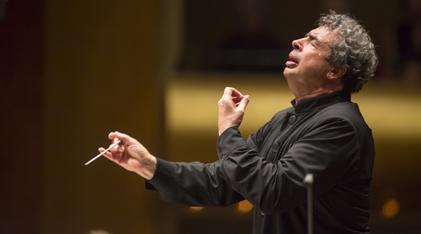by Paul J. Pelkonen

Conductor Semyon Bychkov returned to the New York Philharmonic this week.
Photo by Chris Lee © 2018 The New York Philharmonic.
Mr. Bychkov's last appearance with the orchestra was as the leader of the flagship festival of the 2017 season: a deep celebration of the late symphonies of Tchaikovsky. This festival, called Beloved Friend ended without Mr. Bychkov, who was not available to conduct the concluding concert featuring the Pathetique Symphony. His absence from a work that he had just recorded in a new critical edition carried some considerable weight, and speculation ensued as to why he wasn't on the podium.
This concert did much to dispel those storm clouds. It opened with a crisp reading of Brahms' Tragic Overture, one of a pair that that composer wrote in 1880. Here, this under-programmed work was played with swagger and muscular, round tones by the horns, who sounded revitalized. Mr. Bychkov emphasized the lyricism in this work, producing subtle shadings in the strings and winds and presenting it as much more than just a programming makeweight.
Next was the Philharmonic debut of pianist Bernard Chamayou, playing Mendelssohn's Piano Concerto No. 1. This concerto requires delicate and accurate playing but also considerable force: the composer makes the soloist work the produce the considerable gifts in its pages. Mr. Chamayou proved an apt and eager player, anticipating the roller-coaster turns of the first movement and producing a lovely, singing tone on the second.
The finale is the most challenging of all, a pell-mell Presto that recalls the thematic ideas from the opening in an easy-going classical style. This is the exuberant Mendelssohn of the late symphonies, expressed in bright tones through the expert fingerwork of this young artist. An encore followed that showed even more promise: the lyric "On Wings of Song" in an instrumental arrangement by Franz Liszt.
The second half offered considerably more in the way of excitement in the shape of the Symphony No. 5 by Dmitri Shostakovich. However, Mr. Bychkov took a tight and restrained approach to the first movement, playing the introduction with an icy, slow tempo. When the violence of the main theme burst forth in snare drums and brass, it did so with shattering, frightening power, less the triumphant march of socialism and more of a scream of protest.
This bare-knuckled approach continued in the Scherzo, veering between Mahlerian waltz and Russian circus music. The Adagio was played in deep freeze, creeping along like an ice-locked river with the strings exhibiting precision and control. Everyting detonated in the fourth movement, with pounding drums and blaring trumpets announcing that the new Soviet dawn was rising and the rushed tempos informing the downtrodden masses that there would be nothing they could do to keep up the pace. Brilliant.

